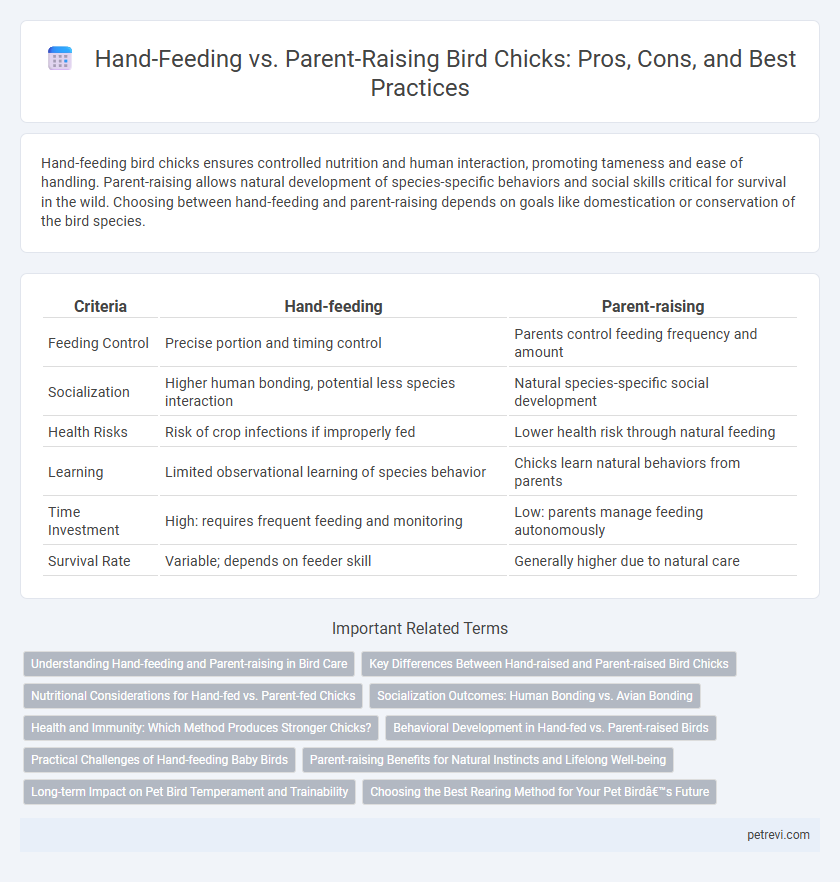Hand-feeding bird chicks ensures controlled nutrition and human interaction, promoting tameness and ease of handling. Parent-raising allows natural development of species-specific behaviors and social skills critical for survival in the wild. Choosing between hand-feeding and parent-raising depends on goals like domestication or conservation of the bird species.
Table of Comparison
| Criteria | Hand-feeding | Parent-raising |
|---|---|---|
| Feeding Control | Precise portion and timing control | Parents control feeding frequency and amount |
| Socialization | Higher human bonding, potential less species interaction | Natural species-specific social development |
| Health Risks | Risk of crop infections if improperly fed | Lower health risk through natural feeding |
| Learning | Limited observational learning of species behavior | Chicks learn natural behaviors from parents |
| Time Investment | High: requires frequent feeding and monitoring | Low: parents manage feeding autonomously |
| Survival Rate | Variable; depends on feeder skill | Generally higher due to natural care |
Understanding Hand-feeding and Parent-raising in Bird Care
Hand-feeding bird chicks involves providing precise nutrition with formulated diets and feeding schedules that promote rapid growth and human imprinting, often used in parrots and exotic species. Parent-raising allows chicks to develop natural behaviors and immune strength through parental care, fostering instinctive social and survival skills essential for wild or aviary birds. Selecting between hand-feeding and parent-raising depends on species-specific requirements, breeder expertise, and the desired outcome for chick development and socialization.
Key Differences Between Hand-raised and Parent-raised Bird Chicks
Hand-raised bird chicks receive consistent human interaction and specialized feeding schedules, leading to increased tameness and easier socialization with people. Parent-raised chicks benefit from natural nurturing behaviors, such as imprinting and learning essential survival skills from their parents, which can result in stronger species-specific instincts. Differences in diet control, social development, and behavioral outcomes highlight the distinct advantages and challenges of hand-feeding versus parent-raising methods.
Nutritional Considerations for Hand-fed vs. Parent-fed Chicks
Hand-fed bird chicks receive precisely formulated diets rich in essential nutrients like proteins, fats, vitamins, and minerals, ensuring optimal growth and development. Parent-fed chicks rely on natural regurgitated food, which varies in nutritional content based on the parents' diet, potentially leading to inconsistencies. Controlled hand-feeding reduces the risk of nutritional deficiencies and supports uniform growth rates compared to parent-raising methods.
Socialization Outcomes: Human Bonding vs. Avian Bonding
Hand-feeding bird chicks promotes strong human bonding, enhancing tameness and ease of handling, which benefits birds intended as pets or for interactive environments. In contrast, parent-raising fosters natural avian bonding and social behaviors vital for species-specific communication and survival skills in the wild. Optimal socialization outcomes depend on whether the bird's future role emphasizes human interaction or natural flock integration.
Health and Immunity: Which Method Produces Stronger Chicks?
Hand-feeding bird chicks can increase human imprinting and stress, which may weaken their immune system compared to parent-raised chicks that receive natural antibodies through regurgitated food. Parent-raised chicks develop stronger health resilience due to continuous exposure to parental microbiota and nutrients essential for immune system maturation. Studies show parent-raised birds typically have higher survival rates and better long-term immunity than hand-fed counterparts.
Behavioral Development in Hand-fed vs. Parent-raised Birds
Hand-fed bird chicks often exhibit increased tameness and socialization with humans due to early and frequent handling, which can enhance bonding but may reduce natural fear responses and survival skills. Parent-raised birds develop more robust behavioral patterns such as foraging, problem-solving, and natural vocalizations, benefiting from observation and interaction with their parents in a natural environment. Studies show hand-fed birds may struggle with species-specific behaviors critical for reproduction and territoriality compared to their parent-raised counterparts.
Practical Challenges of Hand-feeding Baby Birds
Hand-feeding baby birds requires precise knowledge of species-specific dietary needs, feeding frequency, and appropriate formula consistency, making it a labor-intensive process prone to human error. Feeding schedules demand round-the-clock attention to prevent starvation or malnutrition, while improper feeding techniques risk crop infections and aspiration pneumonia. Additionally, hand-fed chicks may develop weaker immune systems and behavioral dependency on humans compared to parent-raised counterparts, necessitating careful socialization and health monitoring.
Parent-raising Benefits for Natural Instincts and Lifelong Well-being
Parent-raising bird chicks promotes the development of natural instincts such as foraging, social interaction, and predator awareness essential for survival. Chicks nurtured by their parents exhibit stronger immune systems and cognitive skills, contributing to enhanced lifelong well-being and adaptability in their natural environment. This method supports behavioral authenticity, reducing stress and fostering resilience compared to hand-fed birds.
Long-term Impact on Pet Bird Temperament and Trainability
Hand-feeding bird chicks often results in stronger human bonding, leading to increased tameness and easier trainability over time. Parent-raised birds may develop more natural behaviors and social skills but can exhibit increased wariness or independence, potentially complicating handling and training. Long-term temperament differences hinge on the early interaction style, influencing pet bird adaptability and owner relationship quality.
Choosing the Best Rearing Method for Your Pet Bird’s Future
Hand-feeding bird chicks promotes early tameness and socialization, resulting in a pet bird more comfortable with human interaction and easier training. Parent-raising fosters natural development of essential survival skills and behaviors, ensuring stronger immune health and species-specific instincts. Selecting the ideal rearing method depends on species, owner experience, and long-term goals for the bird's behavior and health.
Hand-feeding vs Parent-raising for Bird chicks Infographic

 petrevi.com
petrevi.com